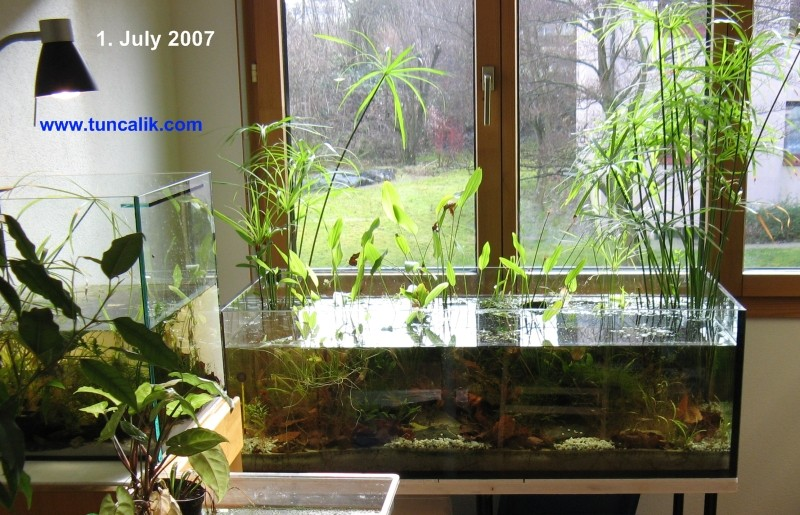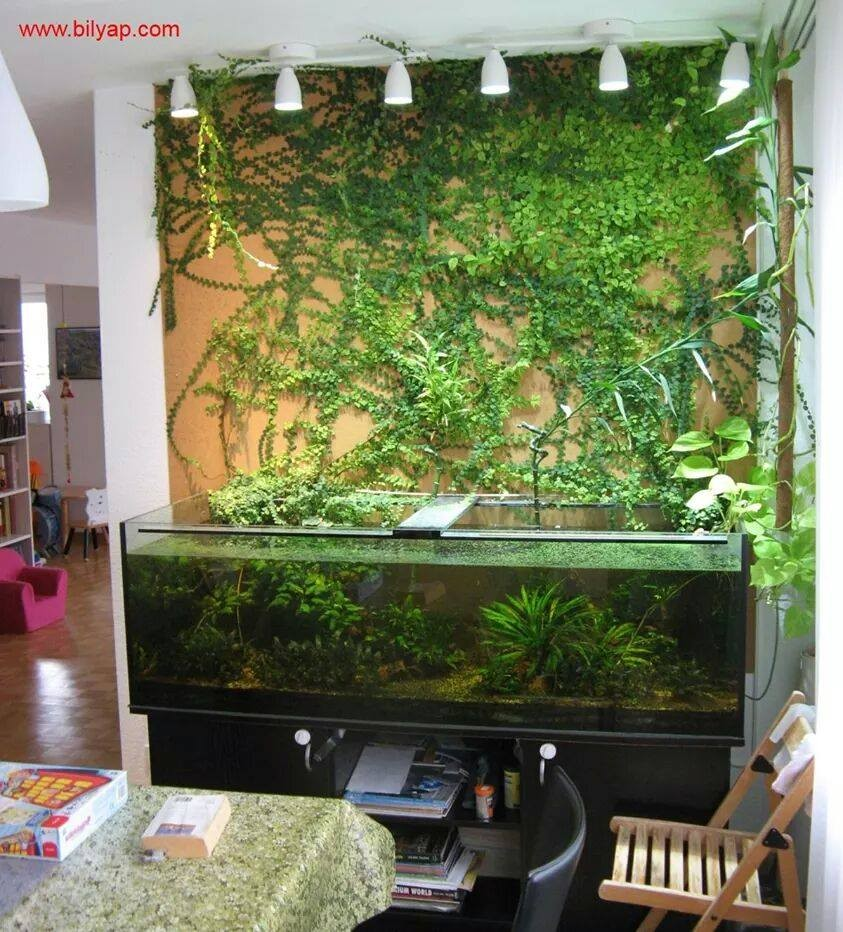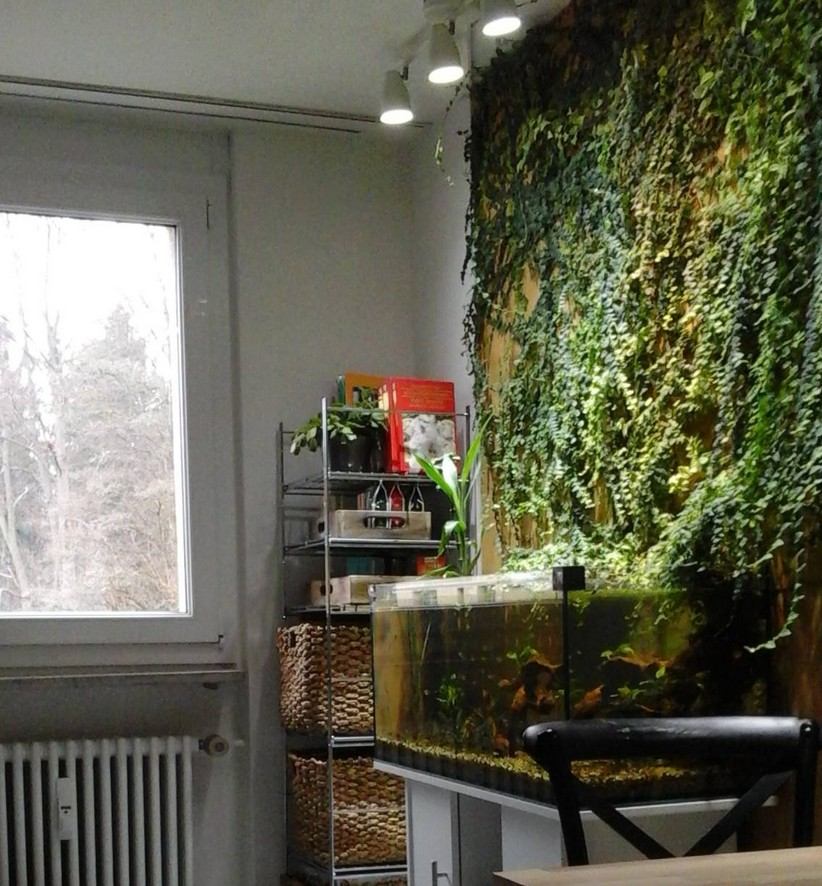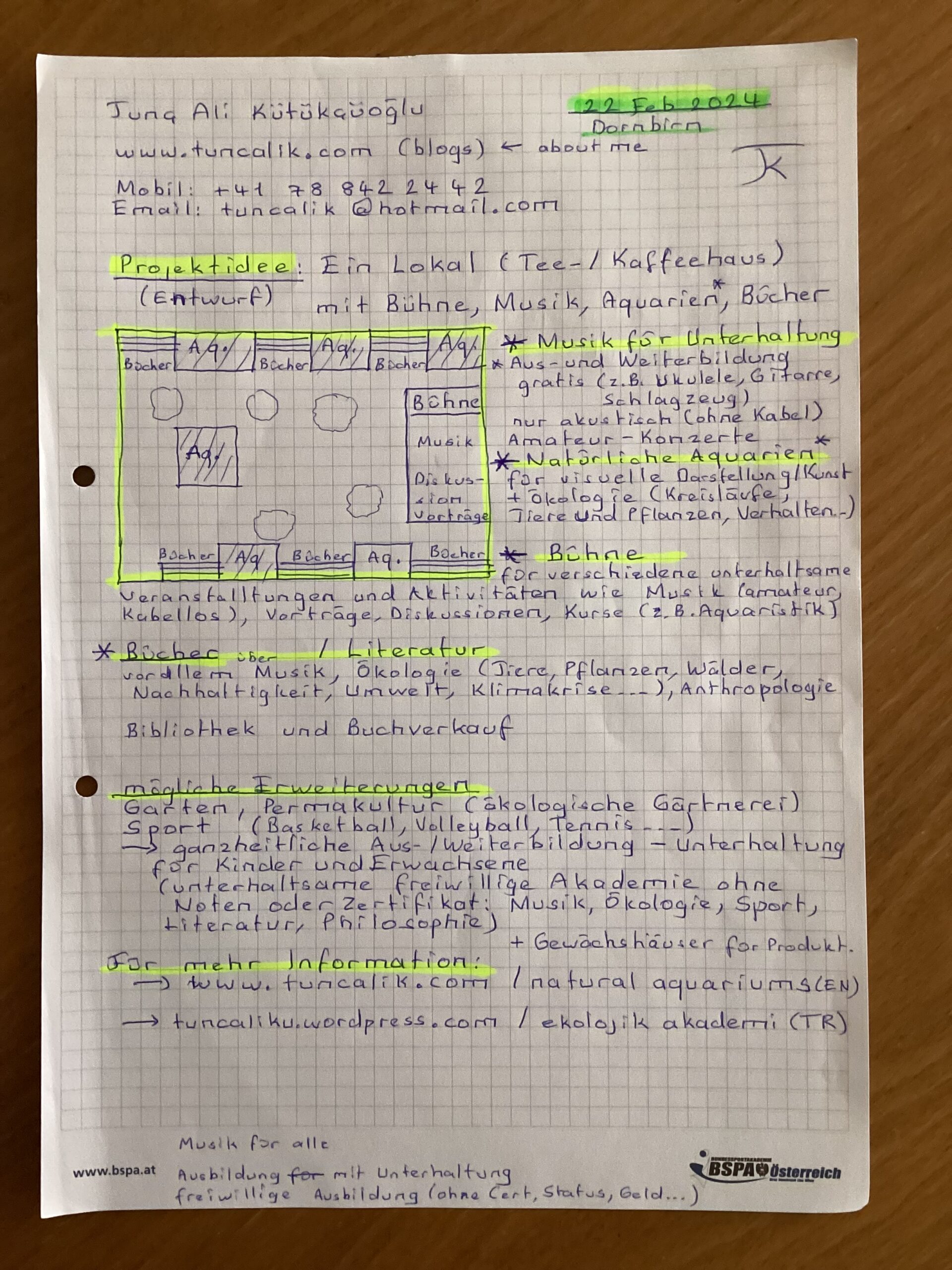Natural aquariums: Sustainable, low-tech, low-maintenance, low-cost aquariums (ecological aquariums)
This is a project idea that I developed in September 2021 to discuss it first with some organisations in Switzerland. You can use it, change it, improve it, and if you like, please share your ideas with me (see contact).
Natural (ecological) aquariums are very much like natural garden ponds that require very little technology and maintenance. Here are some examples of natural and semi-natural freshwater aquariums that I’ve set up so far:
(1) Biotope in my study, a low-tech natural aquarium (blog article)

This low-tech natural aquarium in its first months (YouTube video, 2007)
(2) Semi-Natural Freshwater Aquarium in our Dining Room (2012)

(3) Semi-Natural Freshwater Aquarium in our Kitchen (2017)

Natural aquariums resemble ecological farms as (almost) complete poly-cultural artificial ecosystems with different kinds of plants and animals. The more complete the ecosystem with its complex physical and biochemical cycles, the less human intervention (maintenance) and technology will be required. Hence, we have a low-tech and low-maintenance living system, once the ecosystem has matured properly, like in a permaculture garden (see my tweets for similarities).
There is but an important difference: the biological maturing process of the sand in an aquarium is much faster (about 6 to 12 months) than the maturing process in barren soil without humus (10-15 years). In fact, almost everything seems to happen much faster in an aquarium ecosystem compared to a farm. Ideal ecosystem models for aquariums are of course lakes, rivers and ponds in nature.
Main principle of a natural aquarium can be summarized as maximum ecology minimum technology. In other words, as much ecological automation (distributed, self-organizing organic intelligence) as possible, instead of as much mechanical automation (centralized artificial intelligence) as possible.
Natural aquariums typically have small fish and other small animals like shrimps, snails and amphipods, and lots of plants, and especially marginal plants for sufficient water purification. Typically, I don’t have any filters or heaters in my natural aquariums. This is how I define sustainable aquariums which is open to dispute: Every plant and animal species in the aquarium must be able to live healthily, and multiply itself over multiple generations, for at least 5 years.
With this definition, if any animal or plant species disappears within 5 years, the aquarium is not sustainable. I had once such a sustainable aquarium with Ancistrus catfish, guppies and dwarf shrimps. I had another sustainable aquarium without fish, with amphipods (Hyalella azteca), snails and plants (Najas marina and Lemna minor). Very interesting would be setting up a sustainable aquarium that can accommodate small cichlids like Apiostogramma borellii as the largest predator (i.e at the top of the food web).
Generally, one of the biggest challenges of setting up a sustainable aquarium is keeping the aquarium sand healthy in the long term (i.e. more than 5 or 10 years). So far, my experience showed me that marginal plants with strong roots and tower snails that bury themselves in the sand are quite useful for this purpose. In nature, many different kinds of crustaceans, worms and snails live in the bottom substrate.
The amount of regular water changes could be a good indicator of the completeness of the aquarium ecosystem. For example, weekly water changes of 10% should be enough for the sustainable health of the aquarium. If more water changes are required for the health of animals, this means, the aquarium ecosystem (i.e. biochemical cycles, biological diversity etc.) is not complete or balanced enough.
Project Idea
This project is about developing and setting up different kinds of natural aquariums to use them for multiple purposes, such as:
- Ecology education for children (practical experience with small and simple ecosystems for ecological literacy; learning what a living system or economy requires for sustainability; contact educational organisations and schools…
- Test and develop models for aquaculture (ecosystem modeling). For example, how can we keep the soil substrate healthy in the long term with plants and small animals like snails, worms and crustaceans? Environmental enrichment, species-appropriate keeping and breeding…
- With the help of proper analogies and mappings, certain aspects of even a terrestrial ecosystem like an ecological farm could be simulated and tested with natural aquariums (ecosystem mimicry with broader application).
- Exhibitions (public aquariums); recreation and culture, entertainment value
- Breeding and sale of sustainable plant and animal species that are suitable for natural aquariums (with species-appropriate husbandry; artgerechte Haltung)
- Education, courses and certification for setting up and maintenance of natural aquariums
- Scientific research about animal and plant behavior, dynamic ecosystems etc.
- Using aquariums as training for ecological gardens and farms; surmounting mental barriers like industrial paradigm (mechanistic and reductionist worldview) and technological fundamentalism (dogmatic belief that one can solve every kind of social and ecological problem with artificial human technology)
Implementation
- Evolutionary and incremental development with small steps, and small investments in terms of money and voluntary workforce
- Question: What kind of infrastructure do we already have? Some space in a tropical greenhouse, subtropical greenhouse, winter-garden?
- Possible scenario: Begin with setting up 4-5 natural aquariums (based on well-known simpler models that were already tested for sustainability) before contacting schools for educational or recreational purposes. Each aquarium may require 3-6 months for maturity. Some of them can really be small and simple models without fish. At least one aquarium should contain small cichlids with interesting behavior.
- Prepare detailed information and web presence with videos (like short documentaries) about every natural aquarium: Natural habitats of the animals and plants, existing model aquariums and other inspirations (i.e. culture), ecosystem successions, interesting observations and hands-on experience etc.
- Prepare education packages for schools, children, visitors
- Exhibition may also include an aquaponic system
- Contact potential research and organization partners like zoos, museums, EAWAG, universities; formulate projects for aquaculture (ecosystem mimicry, animal welfare, environmental enrichment), ecosystem and behavior research, ecology education…
Potential Support for the Project (money, information exchange, voluntary work)
- Schools, Ministry of Education (Bildungsdirektion, Volksschulamt Kanton, Gemeinde) and other educational organisations
- Support for research (aquaculture, ecosystem mimicry, ecosystem and behavior, environmental enrichment, fish welfare etc.) from different organisations
- Income from visitors and sales (animals and plants for natural aquariums)
- Income from guided tours, courses, certifications and consulting
- In future: Income from books and videos (e.g. books and videos about natural aquariums)
- To be investigated: Potential synergies with ecological farming, tourism, recreation for elder people, therapeutic activities…
Written by: Tunç Ali Kütükçüoğlu

The same pdf document can be viewed and downloaded here:
Natural Aquariums for Ecological Literacy and Ecosystem Modeling
http://tuncalik.com/wp-content/uploads/2021/03/Project-Idea-Natural-Aquariums-for-Ecological-Literacy-and-Ecosystem-Modeling_20210319.pdf
Another natural aquarium I started to set up in April 2021: Natural aquarium in our balcony with paradise fish from Vietnam
https://www.instagram.com/p/CRiZYBxhqYd/?utm_source=ig_web_copy_link
Balkondaki doğal akvaryum: maksimum ekoloji, minimum teknoloji (video)
EN: Natural aquarium in our balcony: maximum ecology, minimum technology
https://youtu.be/jrp—wdsWU
Do you thing natural aquariums and music get along well?
My daughter Elif Sumru and I played first an old pop song (Mamy Blue) on the ukulele in front of the semi-natural aquarium in our kitchen. Then we talked about the aquarium: fish, plants, maintenance, how plants purify water, natural cycles etc. (in Turkish)
https://www.youtube.com/watch?v=IRZjcSQ4_HE&list=PLlKiATrbw1ktanKE3k6g7W-oXeyQBrxUX&index=15
Pictures from the zero-technology natural aquarium that we set up in the sunlit corridor of our apartment building in Ankara (30 September 2023, instagram/tuncaliku)
https://www.instagram.com/p/Cx0Qj59s523/?utm_source=ig_web_copy_link&igshid=MzRlODBiNWFlZA==
An excerpt from my PhD thesis: This 7th principle of ecology mentioned in the image above (maximum ecology, minimum technology) may explain, why natural aquariums need little technology & maintenance (i.e. external intervention), and also why most aquarium companies & shops (and their investors) don’t like the idea of natural aquarium.
My multidisciplinary project ideas: Books, music, ecology, aquarium
Download project document (pdf) version 13.11.2023
Once established properly within a year or so, natural aquariums are a beauty. In that sense, they are a kind of living visual art. One can produce very attractive documentary videos with music, using modern techniques for close-up filming. So, another outcome of maintaining natural aquariums would be a well visited video channel for documentary films.
Projektidee (Entwurf): Ein Lokal (wie ein Kaffeehaus in einem Gewächshaus) mit Bühne, Naturaquarien, Musik, Büchern (Musik, Ökologie, Literatur)

NATURAL AQUARIUM PRINCIPLES
https://youtu.be/d4WF2VmXric?si=RbuBaVADKn0yo1ZG
In this video, I explained the seven principles of setting up and keeping natural (ecological, low-tech) aquariums, based on my own experience. At the beginning of each section (principle) I played a small piece on the piano.
Unfortunately, I speak in this video in Turkish. Fortunately, you can download here the English transcript of the video translated by chatgbt.
https://www.mediafire.com/file/y7mrzz3r5vsxuxv/NaturalAquariumPrinciples_video-transcript-EN_TuncAliK.pdf/file
There can be some minor errors in the translation; I’ve quickly checked only the broad shape and format of it.
Principles:
1) Maximum Ecology, Minimum Technology
2) Ecosystem, Not Industrial Facility
3) Sustainability and Permanence
4) Aquariums Suitable for the Needs of the Species (in German: artgerechte Haltung)
5) Keeping and Breeding Hardy and Resilient Species
6) Typical Features of a Natural Aquarium
7) Amateur Solidarity
You may notice that these principles are very similar to those of ecological gardening or farming. This is not a coincidence; both are grounded in the same core idea: maximum ecology, minimum technology.
During my mental revolution from conventional (industrial, high-tech) aquariums to natural (ecological, low-tech) aquariums, the hardest barrier to overcome was the “technology fetish”, which is so deeply ingrained in our industrial lifestyle and education.